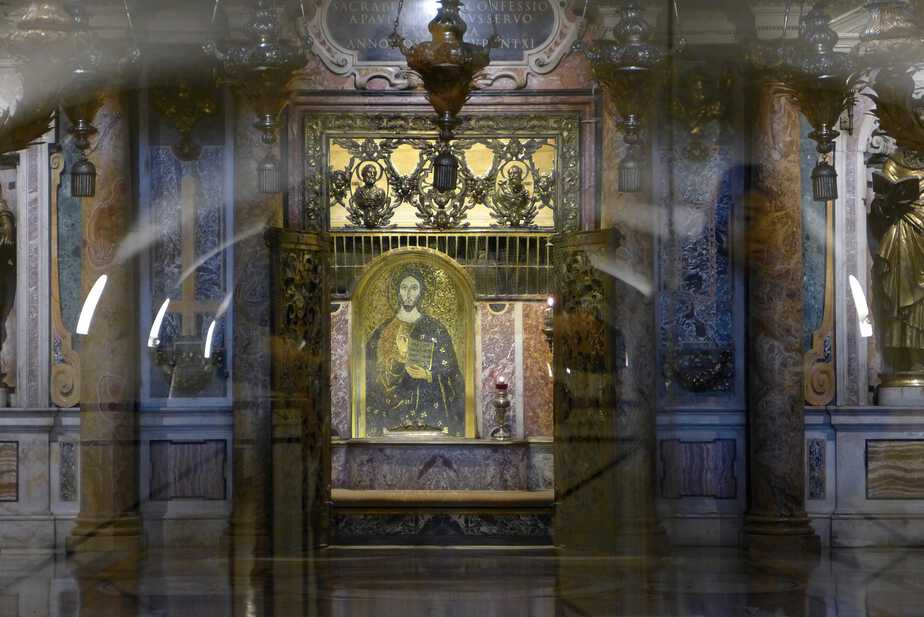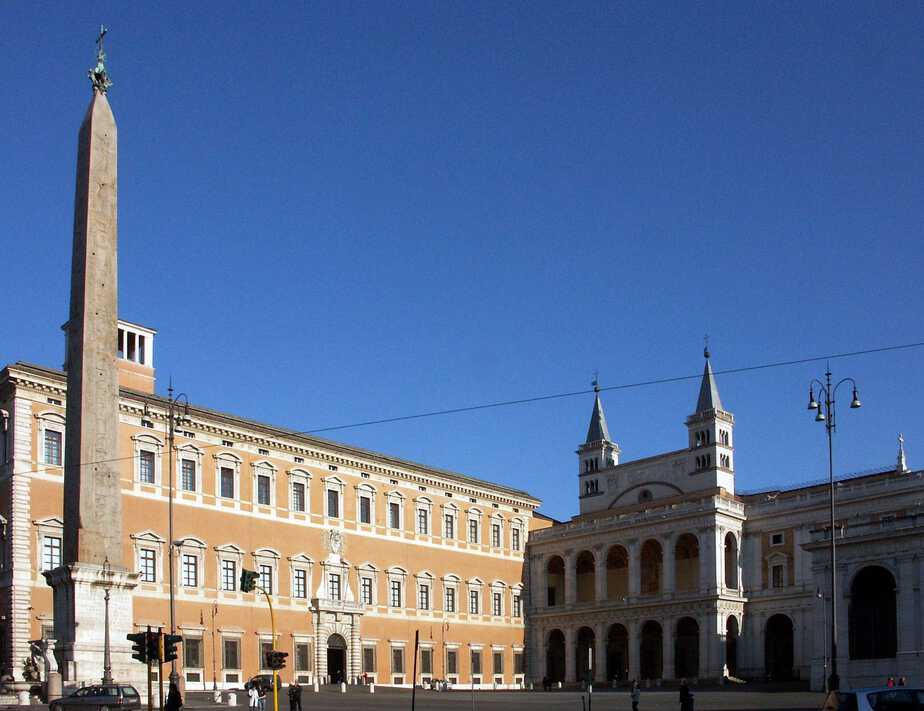Rome is not only the Italian capital but also the city that hosts the Vatican, the smallest State on Earth. The history of the Vatican is almost as old as that of the city. The Papacy ruled Rome for many centuries and was central to some of the main events of Rome.
Knowing the history of the Vatican can help you appreciate your visits to Rome more. Many locations and customs of the Vatican State are connected to the history of the Vatican.
As you walk through the streets of Rome, try to connect the events described in this article to the buildings and monuments of Rome. From the buildings of Ancient Rome to the Italian unification wars, many important events shaped the Vatican. It can be said that the history of the Vatican and that of Rome are indivisible.
The early days of the Vatican
Traditionally, the first Pope is Saint Peter. At the time, being a Christian within the Roman Empire meant being persecuted. Saint Peter himself was executed in Rome. There is even a church, the Domine, Quo Vadis? (in English: Lord, where are you going?) in Rome, that is located where according to the tradition Jesus talked Saint Peter out of fleeing Rome.
At the time the Church was not able to possess any property, nor to celebrate any public ceremonies. Even to celebrate funerals as according to the Christian customs was punished with torture and death.
Due to these risks, wherever Christian believers would go, they built underground burial chambers, Catacombs. These structures can be found everywhere under the city of Rome itself, and many can even be visited with guided tours.
Because of the illegality of their religion, Christians had to gather in private houses, outside the city of Rome. Even though nominally speaking private citizens owned these properties, Christian believers already considered them a part of their collective patrimony.

Saint Peter’s tomb in the Vatican necropolis – by Dnalor 01 – Wikimedia Commons
Nonetheless, they could not be public about their beliefs until the 4th century, when Emperor Constantine established religious freedom in the Roman Empire. Not so long after this opening, those who lived their faith clandestinely before started donating their properties to the at the time Archbishop of Rome.
The Patrimonium Sancti Petri (patrimony of Saint Peter, this was the name given to these properties), the collective properties of the Church, is what historians consider the starting point of the history of the Vatican as a State. As the Roman Bishops started owning more and more properties, their influence on Rome started to grow.
Ticket information:
As mentioned you can visit the catacombs in different locations of Rome. There are two main stops you should consider if you want to see how Christians (and other Romans too, sometimes!) buried their dears. You can visit Domitilla’s catacombs and the Necropolis under Saint Peter’s Basilica.
You can find tickets for a guided tour to Domitilla’s Catacombs, including transport and a tour around Rome, here. The tickets for the tombs under Saint Peter’s Basilica, which include the remainings of Saint Peter himself, can be found here. Additionally, they allow you to skip the line for the Basilica.
The State of the Church
After the Fall of the Roman Empire in 487 and half a century of chaos, the Archbishop of Rome found the protection of the Byzantine Emperor, who had conquered Rome. At the time, he was not the head of the church nor had the title of Pope. He was as important as the other archbishops in Italy.
However, the Byzantines lost their control of Rome through the years. As a result, the Popes became increasingly important in the city government during the following two centuries. The Archbishop of Rome had to wait until the Franks gained control of Central Italy in 751 to become ruler of Rome. Their Emperor gave the Pope the responsibility to rule Rome.
This was the moment in the history of the Vatican State when the Pope started to have political power. The role of the Pope as head of the Vatican State (at the time called State of the Church), was further legitimised by the Donation of Constantine. The Donation was a document declaring that Emperor Constantine had given the Papacy the right to govern Rome after his death. Experts would have found it to be a fake only in the 15th century.
During the 9th century, the Vatican decided to build one of the biggest architectural efforts since Roman times: the Leonine Wall. It was an extension of the Roman walls. The reason behind this project was that the Vatican hill had no fortifications at the time.
You can still see these walls towering over many areas of the Vatican State and the nearby neighbourhood of Borgo. There is a great view of the structure that can be enjoyed from inside the Vatican Gardens.

The Leonine walls as seen from inside the Vatican Gardens – by Dnalor 01 – Wikimedia Commons
ticket information:
You can visit the Vatican Gardens together with the Vatican Museums with tickets from here. These tickets allow you to skip the line as well.
A moment of expansion in the history of the Vatican
From the 8th century onwards, the Vatican had a long period of slow expansion. The State of the Church arrived to control almost every part of Central Italy. Still, a conflict with the French crown undermined the role of the Vatican in the peninsula. Following the conflict, the Vatican established its residency in Avignon, for a period. After, the Vatican split among two Popes up until 1417.
This was the first time since its establishment in the Capital, that the Papacy was not officially located in Rome. As a result of this distance, the Vatican state lost direct control of Central Italy.
A period of reconstruction followed under Pope Martin V, who directed many projects to re-establish the magnificence of Rome in Palazzo Colonna. The Palace is beautiful and full of paintings by some of the most important artists of the period. It is absolutely worth a visit.

The Gallery of Palazzo Colonna – by Sailko – Wikimedia Commons
Ticket information:
Palazzo Colonna is another must-see place if you are not new to Rome. Its history and baroque decorations alone would make it worth a visit. Additionally, the gallery hosts some beautiful paintings with different styles. You can lose yourself in its halls.
You can find the tickets for the Gallery here! Carefully plan your visit, as the Gallery is open only on Saturdays!
The Sack of Rome
Palazzo Colonna was also central in another key event of the history of the Vatican: the sack of Rome, that took place in 1527. When Charles V, emperor of the Holy Roman Empire, won the war with the Vatican State and its allies, he found himself with no way to pay his soldiers. As a result, they decided to reach Rome and take whatever they could find to pay themselves.
During the attack, Palazzo Colonna hosted many civilian refugees. These civilians survived only because a member of the Colonna family participated in the attack. He was moved by the tragedy and chaos caused by the fights to his fellow citizens. Hence, he decided to try to protect the locals and hosted them in his family palace.
The Pope himself survived only because of the Swiss Guard. These soldiers stood ground and fought bravely despite being incredibly outnumbered. Thanks to their courage, the Pope was able to find refuge in Castel Sant’Angelo (in English Castle of the Holy Angel). The Castle connected with the Vatican for emergency cases through a reinforced corridor.
The Swiss guard still celebrates the heroism of that fight. Every year, the new recruits pronounce their oath on the same day the attack happened: May 6th. Unfortunately, the oath ceremony is not public, but many still go to see the Changing of the Guard in Saint Peter’s Square.

A painting of the Sack of Rome – by Johannes Lingelbach – Wikimedia Commons
ticket information:
You can visit Castel Sant’Angelo and see the fortress that protected the Pope during the Sack. Moreover, it is home to some beautiful art pieces and you can enjoy a beautiful view of the city from its terrace! You can buy the tickets here.
The beginning of the end for the Vatican
After the events of the 15th and the 16th century, which undermined the control of the Vatican on its territories and its influence on foreign countries, the Papacy began a process to exercise more direct control on its possessions. This centralisation allowed the Catholic Church to regain strength and to expand further in Central and even Northern Italy.
The Vatican became the hegemonic force in the peninsula. Up until the beginning of the 19th century, no decision was taken in the Italian peninsula without informing the Pope and receiving his approval.
The influence of the State of the Church nonetheless, rapidly declined when in less than a century it suffered three major attacks to its stability. First, there were the French attacks, which took place after the famous revolution. The first attack brought to the creation of the Roman Republic, which only lasted a few years.
After, Napoleon’s expansion in Italy, caused Rome to have no Pope for a decade and damaged his role as a political figure irreparably. As Napoleon and Pope Pio VII were unable to find an agreement, he conquered Rome and established the Pope as a formal head of state. The papacy had to wait until Napoleon’s defeat to regain a real control of Rome and its previous possessions.
One of the darkest periods in the history of the Vatican
After these major damages to the integrity of the State of the Church, the Papacy tried to re-establish its control with reactionary measures which tried to keep the traditional customs alive. This was probably one of the darkest periods in the history of the Vatican.
The restrictive policies damaged the political reputation of the Papacy. Pius IX was nominated Pope in 1847. The Vatican hoped that foreign States and the Roman citizens would look to them more favourably, thanks to the liberal positions of the new Pope. Still, his nomination was not enough to stop the Italian nationalist movement.
The many who started to support the project of unification of Italy under the same flag saw Rome as the most suitable candidate as capital. Because of its history and geographical centrality in the peninsula, it was an ideal starting point for the revolution.
In 1848 a series of protests arose all over the peninsula. The fervour of the Nationalist movement pushed the Roman politicians to rebel against the Pope. They established a laic government, the second Roman republic. Pius IX fled the city.
As a result, many European States feared this could become the start of a process of reunification in Italy. Therefore, they decided to help the Pope re-establish his control. The German and French armies put Rome under siege and won a harsh fight with the Italian nationalists. The Gianicolo hill was the main location where the battles took place.
To honour those who fell, it hosts a statue of Giuseppe Garibaldi, commander of the volunteers. You can take the chance to enjoy the beautiful view of Rome from there. You can also find a French cannonball from the attack, left exactly where it landed in Palazzo Colonna.

View from the Gianicolo hill – image sourced from Civitavecchia Portmobility.it
The unification of Italy
After the short life of the Roman republic, the Papacy benefited from the protection of the French army for a few decades. Even after the foundation of the Italian realm, in 1860, the king decided not to attack Rome as he feared the consequences of a conflict with France.
He had to wait until 1870 when the French soldiers retreated from Rome to fight the Germans in their homeland. The same year, the troops of the Italian realm sieged and conquered Rome. This was the end for the reign of the Pope on Rome and Central Italy.
The Pope decided to refuse the peace treaty proposed by the Italian king. Practically, he became a political refugee. The Italian realm completely dismantled the State of the Church. All of its territorial possessions became part of the Italian realm.
To celebrate the battle which symbolises the unification of the Country, the Italian kingdom built a statue depicting an Italian soldier. It is placed exactly in front of where the troops opened the breach of Porta Pia. If you are interested in the history of the Vatican and that of Italy, this area has high historical significance.

An historical picture of the Breach of Porta Pia – Wikimedia Commons
ticket information:
If you wish to know more about the events that brought to the unification of Italy, you can visit the Museum of the Resurgence. The museum is just behind the Vittorio Emanuele II monument in Piazza Venezia. Unfortunately, you can only buy the tickets at the Museum.
The foundation of the Vatican State
After the fall of the Vatican, the Pope decided to refuse the conditions imposed by the Italian king. The Pope not only refused to recognise the Italian king authority on Rome, but he also refused to accept his role as ruler of the peninsula.
Accordingly, he declared many times that Christians of true faith should have not participated to the Italian elections. On the other side, the Italian kings refused to give back to the Church any of its previous possessions. Additionally, Vittorio Emanuele II and his successors did not want to accept the idea of considering the Church as a foreign entity either.
As a result of these frictions, no actual Vatican State was re-established for more than 50 years. The dictator Mussolini in accordance with the king decided to resolve the officially still ongoing conflict. As a result, in 1929 the king and the Vatican signed the Lateran Treaty.
This treaty re-established some of the possessions of the previous State of the Church in Rome. The Republic confirmed the validity of the treaty in 1947. Thus determining the establishment of the Vatican State as we know it today.
The name of this agreement originates from the palace where it was signed: the Lateran Palace. This beautiful building, still owned by the Vatican to this day, is now home to the Vatican Historical Museum.
The Lateran Palace is a must-see location for all those interested in the history of the Vatican State. Moreover, it is located just next to the magnificent archbasilica of Saint John Lateran, in Saint John’s Square. Wherever you go in the city, do not forget that a piece of history of the Vatican is probably nearby!

The Lateran Palace and Lateran square – Image by Dnalor 01 – Wikimedia Commons
Ticket information:
With the ticket for Saint John’s archbasilica, you can also visit the Lateran Palace and enjoy the part dedicated to the Vatican Historical museum.
You can buy the tickets here. Otherwise, for the visit to the Vatican Historical Museum the ticket of the Vatican Museums is valid as well. You can find the tickets for the Vatican Museums here.
Planning a trip to Paris ? Get ready !
These are Amazon’s best-selling travel products that you may need for coming to Paris.
Bookstore
- The best travel book : Rick Steves – Paris 2023 – Learn more here
- Fodor’s Paris 2024 – Learn more here
Travel Gear
- Venture Pal Lightweight Backpack – Learn more here
- Samsonite Winfield 2 28″ Luggage – Learn more here
- Swig Savvy’s Stainless Steel Insulated Water Bottle – Learn more here
Check Amazon’s best-seller list for the most popular travel accessories. We sometimes read this list just to find out what new travel products people are buying.










